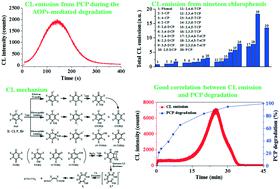当前位置:
X-MOL 学术
›
Environ. Sci.: Water Res. Technol.
›
论文详情
Our official English website, www.x-mol.net, welcomes your
feedback! (Note: you will need to create a separate account there.)
Molecular mechanisms and potential applications of the intrinsic chemiluminescence produced from the degradation of haloaromatic pollutants during environmentally-friendly advanced oxidation processes
Environmental Science: Water Research & Technology ( IF 3.5 ) Pub Date : 2020-05-05 , DOI: 10.1039/d0ew00325e Li Mao 1, 2, 3, 4, 5 , Hui-Ying Gao 1, 2, 3, 4, 5 , Bo Shao 1, 2, 3, 4, 5 , Chun-Hua Huang 1, 2, 3, 4, 5 , Ben-Zhan Zhu 1, 2, 3, 4, 5
Environmental Science: Water Research & Technology ( IF 3.5 ) Pub Date : 2020-05-05 , DOI: 10.1039/d0ew00325e Li Mao 1, 2, 3, 4, 5 , Hui-Ying Gao 1, 2, 3, 4, 5 , Bo Shao 1, 2, 3, 4, 5 , Chun-Hua Huang 1, 2, 3, 4, 5 , Ben-Zhan Zhu 1, 2, 3, 4, 5
Affiliation

|
The ubiquitous distribution of halogenated aromatic compounds (XAr) coupled with their carcinogenicity has raised public concerns over their potential risks to both human health and our ecosystem. Recently, advanced oxidation processes (AOPs) have been considered as an “environmentally-friendly” and green technology for the degradation of such recalcitrant and highly toxic XAr. During the course of our study on metal-independent generation of hydroxyl radicals (˙OH) by halogenated quinones and H2O2, we found, unexpectedly, that an unprecedented ˙OH-dependent intrinsic chemiluminescence (CL) can be produced by H2O2 and polyhalogenated quinones. Further investigations showed that, in all ˙OH-generating AOPs, CL can also be produced not only by pentachlorophenol and all other halogenated phenols, but also by all XAr tested. A systematic structure–activity relationship study for all nineteen chlorophenol congeners showed that the CL increased with an increase in the number of chlorine-substitutions in general. More importantly, a relatively good correlation was observed between the formation of quinoid/semiquinone radical intermediates and CL emission. Moreover, for those halogenated hydroxy-quinoid pollutants, much stronger CL emission and better degradation could be induced by cobalt(II)-mediated Fenton-like systems, and ˙OH produced site-specifically was found to be responsible for this unusual CL emission. On the basis of these results, a rapid, sensitive, simple, and effective CL-based analytical method was developed not only to measure and quantify trace amounts of XAr and related haloquinoid compounds, but also to monitor their degradation kinetics and provide useful information for predicting their toxicity. These findings may have broad chemical, environmental and biological implications for future studies on halogenated aromatic persistent organic pollutants.
中文翻译:

在环境友好的高级氧化过程中由卤代芳香族污染物降解产生的内在化学发光的分子机制和潜在应用
卤代芳族化合物(XAr)的普遍分布及其致癌性引起了公众对其潜在危害人类健康和生态系统的担忧。最近,先进的氧化工艺(AOP)被认为是降解此类顽固和高毒性XAr的“环保”绿色技术。在我们研究卤代醌和H 2 O 2与金属无关的羟基自由基(˙OH)生成过程中,我们意外地发现,H 2可以产生前所未有的unprecedentedOH依赖性内在化学发光(CL)Ø 2和多卤代醌。进一步的研究表明,在所有生成OH的AOP中,CL不仅可以由五氯苯酚和所有其他卤代苯酚生成,而且还可以由所有测试的XAr生成。一项针对所有十九种氯酚同类物的系统结构-活性关系研究表明,氯的含量通常随着氯取代基数量的增加而增加。更重要的是,在醌/半醌自由基中间体的形成与CL发射之间观察到相对良好的相关性。此外,对于那些卤代羟基喹啉类污染物,钴可以诱导更强的CL排放和更好的降解(II)介导的Fenton样系统,并发现特定位置产生的OH负责这种异常的CL发射。在这些结果的基础上,开发了一种快速,灵敏,简单且有效的基于CL的分析方法,不仅可以测量和量化痕量XAr和相关卤代喹啉化合物,还可以监测其降解动力学并提供有用的信息以供参考。预测其毒性。这些发现可能对未来的卤代芳香族持久性有机污染物的研究具有广泛的化学,环境和生物学意义。
更新日期:2020-05-05
中文翻译:

在环境友好的高级氧化过程中由卤代芳香族污染物降解产生的内在化学发光的分子机制和潜在应用
卤代芳族化合物(XAr)的普遍分布及其致癌性引起了公众对其潜在危害人类健康和生态系统的担忧。最近,先进的氧化工艺(AOP)被认为是降解此类顽固和高毒性XAr的“环保”绿色技术。在我们研究卤代醌和H 2 O 2与金属无关的羟基自由基(˙OH)生成过程中,我们意外地发现,H 2可以产生前所未有的unprecedentedOH依赖性内在化学发光(CL)Ø 2和多卤代醌。进一步的研究表明,在所有生成OH的AOP中,CL不仅可以由五氯苯酚和所有其他卤代苯酚生成,而且还可以由所有测试的XAr生成。一项针对所有十九种氯酚同类物的系统结构-活性关系研究表明,氯的含量通常随着氯取代基数量的增加而增加。更重要的是,在醌/半醌自由基中间体的形成与CL发射之间观察到相对良好的相关性。此外,对于那些卤代羟基喹啉类污染物,钴可以诱导更强的CL排放和更好的降解(II)介导的Fenton样系统,并发现特定位置产生的OH负责这种异常的CL发射。在这些结果的基础上,开发了一种快速,灵敏,简单且有效的基于CL的分析方法,不仅可以测量和量化痕量XAr和相关卤代喹啉化合物,还可以监测其降解动力学并提供有用的信息以供参考。预测其毒性。这些发现可能对未来的卤代芳香族持久性有机污染物的研究具有广泛的化学,环境和生物学意义。











































 京公网安备 11010802027423号
京公网安备 11010802027423号